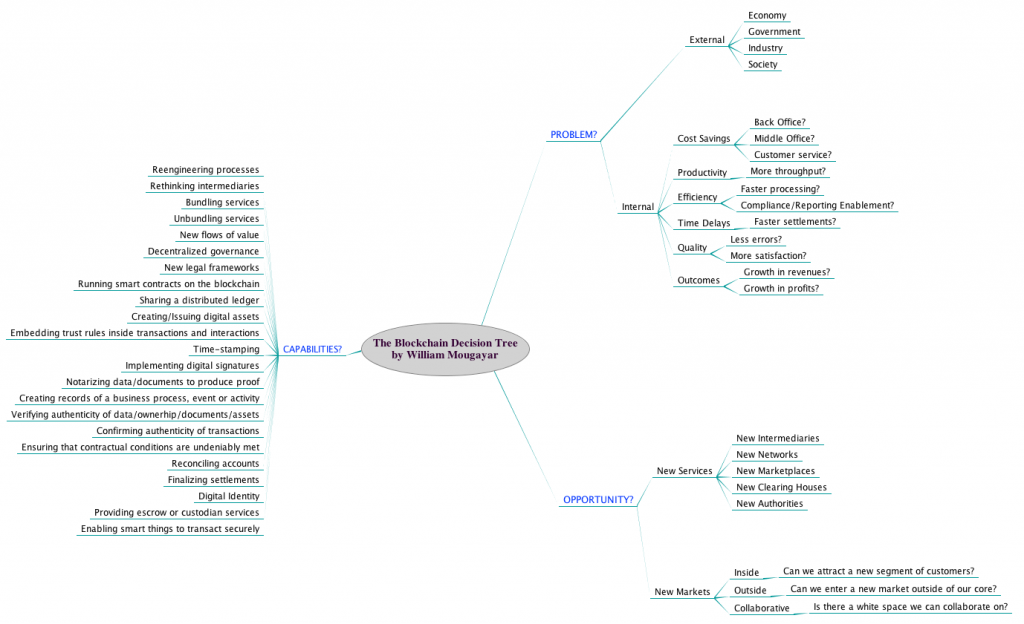I was recently trying to explain the blockchain and its impact on financial services to a smart McKinsey consulting professional, and he said to me: "What problem is the blockchain solving?"
It was an inquisitive question that led me to organize my thinking by categorizing the blockchain's impact into 3 broad categories:
1) Solving Problems, 2) Creating Opportunities, 3) Applying Capabilities.
Solving Problems
The "problems" category comes in a variety of flavors. It forces the thinking around understanding if the blockchain has immediate applications that could impact:
- Cost savings
- Productivity
- Efficiency
- Time delays
- Quality
- Outcomes
That list is not a list of “problems” in the pure sense of the word, but it is a list of fundamental business parameters that any organization wishes to streamline. In this case, the blockchain is an invisible enabler that doesn't change much to the externally visible parts of a business. It’s more of an internal black box that does something differently than before.
As I said previously, corporations did not plan for the blockchain two years ago. It was a 2015 surprise mostly, and many of them are planning for it now. This means we may only start to see flushed out plans and full realizations take shape in 2-3 years, given the latency of planning processes and realistic post-planning implementations.
Of course, the above list represents an internal organizational view on problem solving.
Taking an external view, there are larger, global problems that are also potential targets for the blockchain, and they are related to the economy, industries, government or society. Some of these have philosophical or ideological roots that are driving them. Pick your flavor of grievance or issue around the world, and there might be a decentralization-based flavor of a solution, which is undoubtedly linked to a blockchain.
But just asking what problem the blockchain solves is a limiting question, on its own. For example, if you look at the startup innovation around banks in FinTech, you will see plenty of cases where these new companies didn't really solve a “problem” the banks had, but they tackled a particular market or service differently. So the tipping point was to compete by re-framing the opportunity, e.g. peer to peer lending, unconventional home loans, efficient robot investing, etc. This leads us to the next aspect: the Opportunity view.
Creating Opportunities
It is more difficult to figure out opportunities, because it requires applying innovation, being creative, and making more profound changes. These are more difficult objectives than cost savings, because business process changes are involved, and it takes a lot longer to change them. When you sum it up, the blockchain is about 80% business process changes, and 20% technology implementation.
New Opportunities include entering new markets and/or providing new services that the blockchain enables and that were not possible before. It requires a more imaginative process of dreaming up what's possible and what wasn't done before. It requires thinking outside the proverbial box, and a deep understanding of what the blockchain can enable in the areas that it is strongly suited for.
These new opportunities could also develop as new markets around 3 spaces: inside your organization, collaboratively between two or several organizations, or in totally new areas that don't initially interface with internal processes. Arguably, anything done on the outside might be easier to tackle because you’re not initially tied down by your core integration requirements.
Applying Capabilities
This brings us to the third category of thinking: applying the blockchain’s capabilities from the ground-up. In other words, the starting point here is a deep understanding of what the blockchain enables, and there is a long list of jumping points that I’ve already written about in Explaining the Blockchain’s Impact via an Infographic, and expanded on it via the following decision tree diagram.
It’s a lot easier for someone to understand the blockchain than for a blockchain person to understand someone’s business.
For example, you can't directly compare the blockchain to a database and say - the database does this better therefore we don't need blockchain transactions. The blockchain is a new paradigm. Rather, start by running smart contracts on a blockchain, and ask yourself what it can enable, then work backwards to see how you can tie it back to your business. There is a certain magic that occurs when you're running business logic on a decentralized consensus layer that is not controlled by any single entity, yet it is jointly owned and operated by several parties who collectively benefit from this arrangement. There is magic when you figure out the blockchain’s touch points to your business and you start offering new user experiences that didn't exist before.
When looking at your blockchain strategy, I believe that you need to tackle all three elements in parallel: problem solving, opportunities discovery and capabilities enablement. That's the trinity of sanity for an organizational blockchain strategy.

